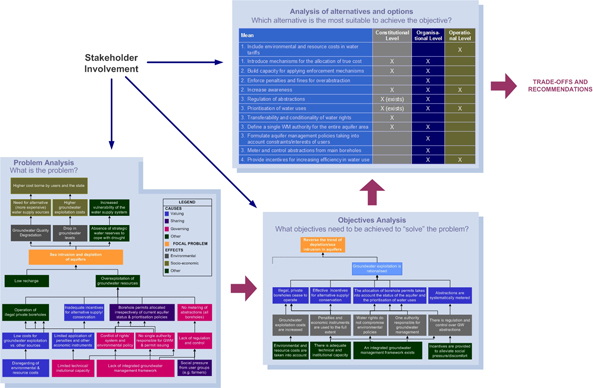|
During its first year, the INECO Project focused on the
selection of focal water management problems in each region.
These issues will be the basis for the identification of
alternative institutional and economic instruments targeting
the problem causes and/or the mitigation of their effects.
The overall process adopts the Analysis Phase Method of the
Logical Framework Approach, and includes the following
stages: 1. Problem Analysis:
Identification of stakeholders, their key problems,
constraints and opportunities and determination of cause and
effect relationship between threats and root causes;
2. Analysis of objectives: Development of objectives
from the identified problems and identification of means to
end relationships 3. Strategy
analysis:
Definition and evaluation of potential strategies to achieve
objectives.
The identified problems which will be the basis for all
future Project Activities have been consolidated through
local stakeholder meetings, in order to ensure that the
selected issues are in line with the needs of the
local societies.
In the second year of the project, Objectives and
Alternatives will be extensively discussed and a set of
recommendations and potential trade-offs will be identified,
as depicted in the Figure below.
|
The set of Case Studies defined for each region are the
following:
-
Cyprus:
Aquifer depletion and sea intrusion
-
Tunisia:
Groundwater Depletion and Salinisation
-
Egypt:
Water quality deterioration
in the region of Bahr Basandeila Canal, of the Dakahlia
Governorate
-
Lebanon:
Decrease in the total amount of surface and groundwater
of adequate quality required for meeting the water needs
of domestic, agricultural and industrial users in the
Damour River Basin
-
Syria:
Water pollution related-problems in the Barada
River Basin (Greater Damascus Area)
-
Morocco:
Inefficient water use in the Oum Er Rbia
River Basin
-
Algeria: Water pollution in the Seybousse River
Basin
A summary
description of the above issues is provided in this
newsletter. More details on the analysis carried out
individually in each country and region, are available at
the respective sections of the
INECO
web site.
|


